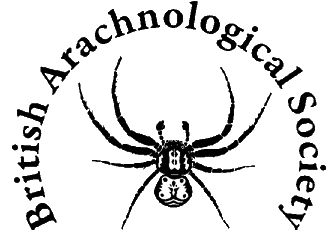Introduction
False widow spiders belong to the genus Steatoda and the term is most often used in reference to three species found in association with or near buildings and gardens, Steatoda bipunctata, Steatoda grossa and Steatoda nobilis. All have globular shaped bodies and their name derives from the fact that they are commonly mistaken for black widow spiders which are in a different genus (Lactrodectus), but the same family (Theridiidae). Black widow spiders are not found in the UK but are very rarely unintentionally imported. Click here to download our information sheet on false widow spiders (or here to find out how to order commercially printed copies).
The False Widow Species
Steatoda bipunctata
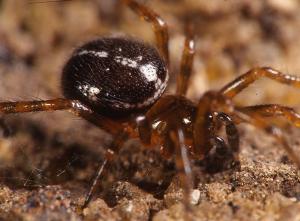
Steatoda bipunctata (sometimes known as the 'rabbit hutch spider') is usually the smallest of the three and a very common spider of sheds and outbuildings. Its body, which rarely exceeds 7mm in length for mature females and 5mm for males, is dark and shiny with a pattern, when present, comprising a whitish line around the front and sometimes a white stripe down the centre (see photo). The impressed dots on the abdomen from which it gets its scientific name are not easily visible with the naked eye. A distribution map for this common and widespread native species can be viewed by going to the Society's Spider Recording Scheme website.
Steatoda grossa
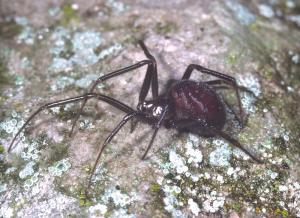
Steatoda grossa has a body length when mature of around 10 mm for adult females and again males are generally smaller. It is variable in appearance, with only juveniles and adult males usually having a pattern and adult females often having none.
This native species has become more frequent in the south-east and is probably spreading north, with records as far north as the Orkneys as can be seen on the distribution map.
Steatoda paykulliana
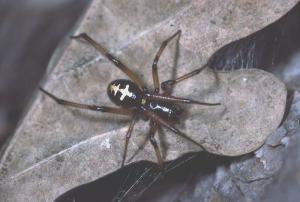
Steatoda paykulliana sometimes occurs in imported grapes and other fruit and is often misidentified as a Black Widow, Lactrodectus mactans or a Redback spider, Lactrodectus hasselti. It can deliver a painful bite but the venom is quite mild in its effect.
The true Black Widow spider can easily be distinguished from the preceding species. It is black with a distinctive bright red 'hour-glass' mark on the underside of its abdomen.
Steatoda nobilis
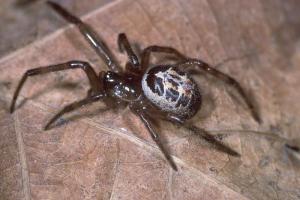
Steatoda nobilis, the 'noble false widow', is the largest of the false widows with a maximum body length of 14mm for females and 10mm for males. The body pattern shown on the photo is typical but it can be less pronounced, especially in females. Unlike Steotoda bipunctata and S. grossa, which are native to this country, this spider is thought to have been introduced to the UK and was first recorded at Torquay in 1879. For the next 100 years or so it was confined to a few populations along the south coast but it is now spreading, probably as a result of global warming. By the end of 2015 it had reached Lincolnshire and North Wales; see distribution map on the SRS web site.
Webs
False widow webs are a tangled scaffold of silk with the spiders usually confined to a crack or crevice in the wall or similar structure. These spiders should not be confused with Amaurobius similis, which has a similar body pattern and is a common species found on walls, fences, garages and outbuildings, the web of which is a lace-like pattern of irregular silk surrounding a hole, often with a blueish tinge.
Spider Bites
Only a very small number of the larger species of British spiders have fangs capable of penetrating human skin. There have been a number of reports of people being bitten by spiders and false widows are often the focus of this, particularly in the media. However, it is difficult to obtain accurate evidence as those complaining of bites often do not see the spider but assume they are the culprit because of the absence of a bee or wasp. Alternatively, they only get a brief glimpse. Rarely is a spider captured and an accurate identification carried out.
Steatoda nobilis and occasionally Steatoda grossa have been implicated in bites on humans. A young woman in Worthing was recorded as being bitten by a female Steatoda nobilis (Snazell & Jones 1993, Bulletin of the British Arachnological Society Vol 9[5] 164-167) and in 2009, there was a report of a woman from West Cumbria being bitten by a false widow spider which allegedly caused her to suffer from an allergic reaction. Indeed, it would appear that such a reaction is likely to be the most likely cause of a serious problem to humans as otherwise the bite has been compared to a wasp sting. In fact, when one considers the undoubtedly large number of people who are stung each year by wasps and bees, the risk of being bitten by a false widow spider must surely be relatively small. False widows are sedentary by nature, remaining in their webs and the males are only likely to wander when they are ready to mate. Being bitten is therefore likely to be the result of putting a hand into a web, handling one roughly or sitting or lying on one by mistake. Reports of bites by false widows are difficult to substantiate and often highly exaggerated by the media.
In summary, being bitten by a spider is very unlikely in this country in normal circumstances, and the effect of a bite is unlikely to be worse than being stung by a wasp or bee. A more serious problem is only likely to arise in the event of an allergic reaction, infection of the bite or if the person is already compromised by other health issues.
Nevertheless, if severe swelling or ulceration results from a suspected spider bite it is recommended that you see your doctor immediately or visit an Accident and Emergency Department.
- See also spider bites in the UK.
